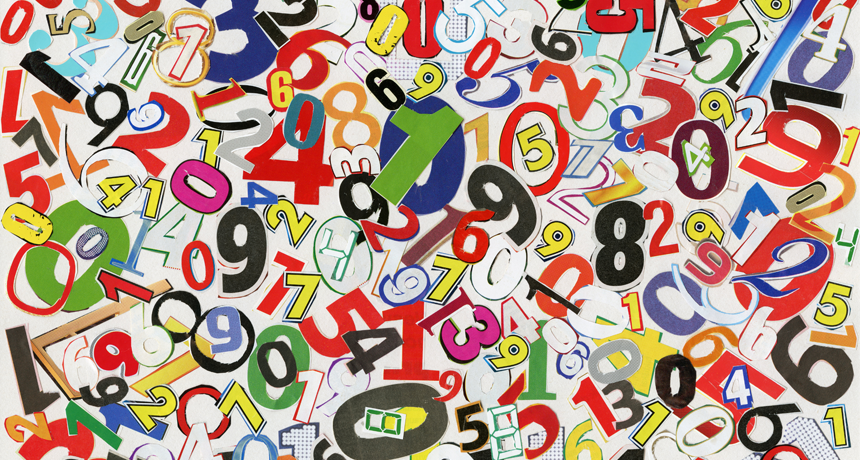Two numbers set a record — and not just for being book length
Massive online collaboration finds the largest known ‘twin’ primes

Numbers as long as a book are now the largest-known twin primes.
donatas1205/istockphoto
By Evelyn Lamb
On September 14, the largest known twins were born. These bouncing babies were not of the human variety. Nor were they blue whales, elephants or some other large creatures. They were numbers. And not just any numbers. They belong to a special class known as prime numbers. Writing just one of them out would fill up about 130 pages of text — a decent-length book. So these numbers are truly massive.
Their discovery was made by Tom Greer. He’s an information technology professional from San Marcos, Texas. Greer’s work was part of PrimeGrid, a massive online project that allows anyone with a computer to join the search for large prime numbers.
A prime number is a whole number that can be cleanly divided only by itself and 1. So 2 and 3 are primes, but 6 — divisible by 2 and 3 — is not. To qualify as twins, these primes must differ by only 2, such as 5 and 7 or 11 and 13.
Prime numbers have fascinated people since at least the time of the ancient Greeks. “They’re like the atoms of the numbers,” says Lola Thompson. She is a mathematician at Oberlin College in Ohio. She studies these unusual numbers. “Understanding the primes is like understanding the building blocks of all numbers,” she argues.
In the mid-twentieth century, people realized that prime numbers could have some very practical uses, too — in encryption.
Encryption is the process of hiding data within some code so that unauthorized people cannot see or interpret it. If you want to send a message on the internet, for example, you can encrypt it to keep spies from finding out what you wrote. One of the most popular methods is called RSA encryption. (The letters RSA were taken from the last names of the three people who described the method.) To work, this technique relies on large prime numbers — ones with hundreds of digits.
But the new twin primes are far too large to use in RSA encryption. Chris Caldwell compares them to diamonds. He is a mathematician at the University of Tennessee in Martin.
Small prime numbers are like diamond dust, he says. Diamond dust is used to cut very hard materials. Smaller prime numbers can be used in cryptography. But you wouldn’t use a big diamond for cutting something. You would want to display it in a fabulous piece of jewelry — even in a museum (as the Smithsonian Institution’s Hope Diamond is). The largest prime numbers can be thought of in a similar way, Caldwell says.
PrimeGrid is “a collaboration between programmers, scientists and mathematicians to put all their skills together in one place,” explains David Underbakke. A computer programmer from Minneapolis, Minn., he wrote one of the programs used to find the new twin primes. “No one person has the skills to do it all,” he says.
To find huge new prime numbers, projects like PrimeGrid use many different computer programs. Each performs a different part of the task. Some are known as sieves. They filter out lots of numbers that are not primes so that people don’t waste their time testing these. Other programs perform “primality” tests. That means they take one number and determine whether or not it is prime. To make sure their answers are right, people use several different programs to check their work. All in all, a number goes through a rigorous screening process before it emerges victorious as a confirmed prime number.
Finding new prime numbers and new twin primes means testing ever-larger numbers. The newly confirmed twin primes are huge. To write out either one requires 388,342 digits. That would be like writing 2,774 tweets on Twitter.
Twin primes interest mathematicians for another reason. It has to do with the infinite nature of numbers. (Infinite means that something can go on forever.) There are an infinite number of numbers. And mathematicians know that there are infinitely many prime numbers, too. They suspect that there may be an infinite number of twin primes. That suspicion is known as the “twin prime conjecture.”
Yitang Zhang is a mathematician at the University of California, Santa Barbara. In 2013, he took a huge step toward proving the twin prime conjecture. He was then at the University of New Hampshire in Durham. And there he showed that there are infinitely many primes that differ by at most 70 million numbers. Yes, a mere 70 million!
That may not sound astounding, but it is “a big deal,” Thompson maintains. The reason? “We went from not being able to show it for any finite number to being able to show it for 70 million.” Mathematicians have since lowered the gap from 70 million to just 246.
Now they’re working to narrow that difference down to just 2.







